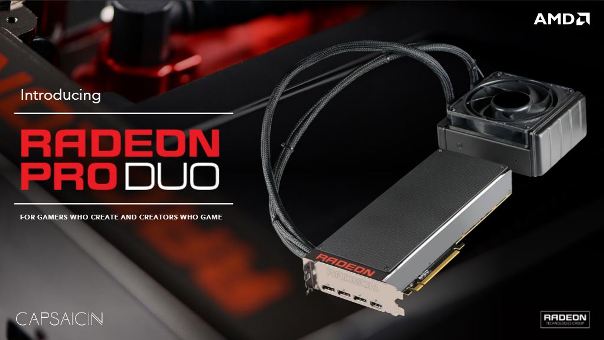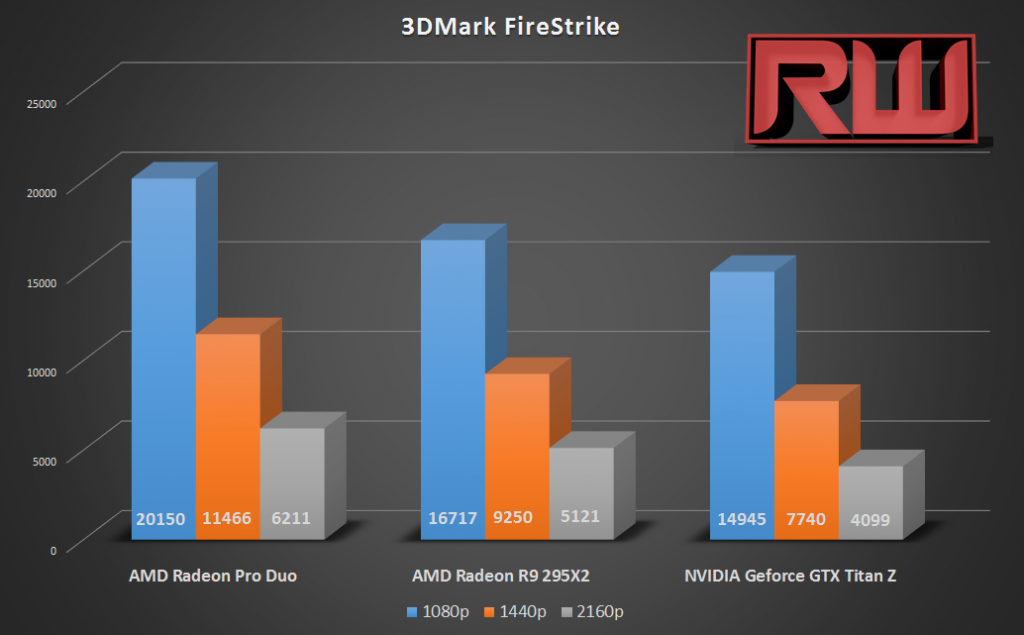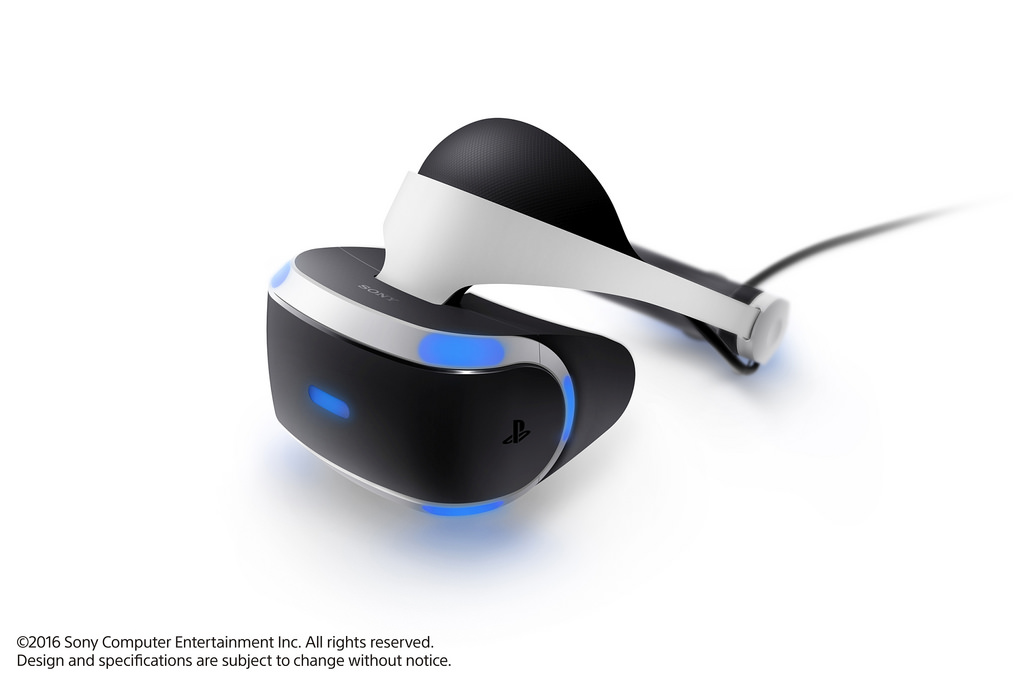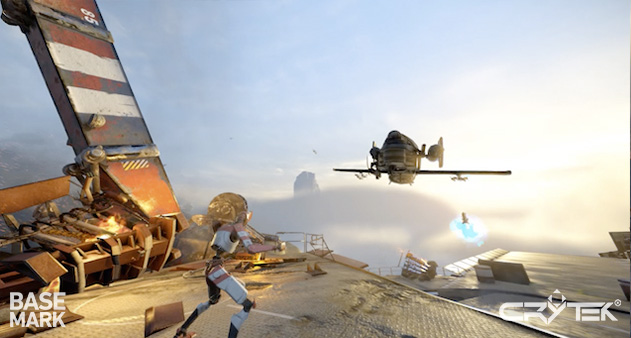The Dual Fiji card we’ve been expecting for quite some time is finally a reality; AMD announced that the Radeon Pro Duo will finally be released during Q2 2016.
First of all, the press release:
AMD (NASDAQ: AMD) today introduced the world’s most powerful platform for virtual reality (VR) , capable of both creating and consuming VR content. AMD’s Radeon™ Pro Duo with its LiquidVR SDK is a platform aimed at most all aspects of VR content creation: from entertainment to education, journalism, medicine and cinema. With an astonishing 16 teraflops of compute performance, AMD offers a complete degree solution aimed at all aspects of the VR developer lifestyle: developing content more rapidly for tomorrow’s killer VR experiences while at work, and playing the latest DirectX 12 experiences at maximum fidelity while off work.
AMD continues to solve major problems developers face by reducing latency and accelerating the VR pipeline through close collaboration with the content development community and with AMD LiquidVR technology. AMD’s next step in advancing VR is with the new AMD Radeon Pro Duo, an incredibly advanced and powerful dual-GPU board that delivers the horsepower needed by VR designers, content creators, and for VR content consumers.
“More powerful computing platforms are rapidly leading to greater immersive experiences, said Raja Koduri, senior vice president and chief architect, Radeon Technologies Group, AMD. “This is most evident with VR which demands ever higher compute performance with rock solid consistency. Our new AMD Radeon Pro Duo with our LiquidVR SDK is the world’s fastest platform for both content creation and consumption1, enabling a world class graphics and VR experience.”AMD Radeon Pro Duo is the initial product of the AMD VR Ready Creator line. The AMD Radeon Pro Duo with the LiquidVR SDK is also the platform of choice for Crytek’s VR First initiative for nurturing new talent in the field of virtual reality development by powering virtual reality labs in colleges and universities worldwide.
“As a state of the art platform, the AMD Radeon Pro Duo with the LiquidVR SDK is the perfect choice as the graphics standard for Crytek’s VR First initiative,” said Cevat Yerli, CEO, Crytek. “As a graphics card that bridges the needs of both VR content creators and content consumers, it’s extremely fitting hardware to supply to the brightest up-and-coming developers, who will surely shape the future of virtual reality and immersive computing.”
and the card’s rumoured specifications:
| Fabrication Process | 28nm |
| GPU | Fiji XT x2 |
| Streaming Processors | 2x 4096 |
| Graphics memory | 2x 4 GB HBM |
| Memory Clock | up-to 500 MHz / 1.0 Gbps |
| Core Clock | 1050 MHz |
| Memory Bandwidth | up-to 512 GB/s |
| Power Connectors | 3 x 8-pin |
| Form Factor | Full Height, Dual slot |
| Freesync | Yes |
| DirectX 12 Support | Yes |
| Fabrication Process | 28nm |
| GPU | Fiji XT |
| Streaming Processors | 4096 |
| Graphics memory | 4 GB HBM |
| Memory Clock | up-to 500 MHz / 1.0 Gbps |
| Core Clock | 1050 MHz |
| Memory Bandwidth | up-to 512 GB/s |
| Power Connectors | 2 x 8-pin |
| Form Factor | Full Height, Dual slot |
| Freesync | Yes |
| DirectX 12 Support | Yes |
| Fabrication Process | 28nm |
| GPU | Fiji XT |
| Streaming Processors | 4096 |
| Graphics memory | 4 GB HBM |
| Memory Clock | up-to 500 MHz / 1.0 Gbps |
| Core Clock | up-to 1000 MHz |
| Memory Bandwidth | up-to 512 GB/s |
| Power Connectors | 1 x 8-pin |
| Form Factor | Full Height, Dual slot |
| Freesync | Yes |
| DirectX 12 Support | Yes |
| Fabrication Process | 28nm |
| GPU | Hawaii / Grenada |
| Streaming Processors | 2816 |
| Graphics memory | 8 GB GDDR5 |
| Memory Clock | 6.0 Gbps |
| Core Clock | 1050 MHz |
| Memory Bandwidth | 384 GB/s |
| Power Connectors | 1 x 6-pin – 1 x 8-pin |
| Form Factor | Full Height, Dual slot |
| Freesync | Yes |
| DirectX 12 Support | Yes |
Design-wise the card is longer than the Fury X, and it utilises a liquid cooling solution. It will offer 16 TFlops of performance and comes with 8GB HBM1 graphics memory and 8192 stream processors. One thing that is striking from the press photos is the three (yes, you read that right) 8-pin power connectors which means the card could use up to 525 Watt, although you will probably never see that number in real life. The card will feature three DisplayPort 1.2 connectors and one HDMI port. The card was on show on the Capsaicin event, and we also have some preliminary 3DMark benchmark numbers. If you are in the market for such a card, bear in mind that it’ll cost you; AMD gave us a suggested retail price of $1499.








Add Comment